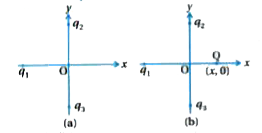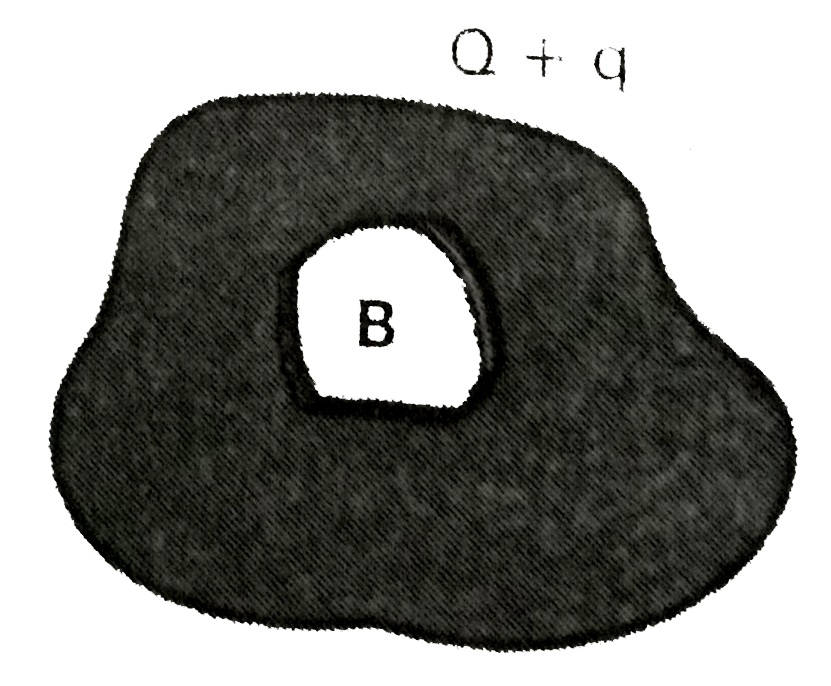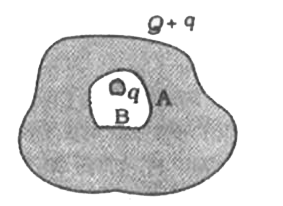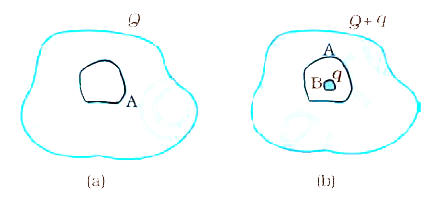(a) A conductor A with a cavity as shown in figure (a) is given a charge Q. Show that the entire charge must appear on the outer surface of the conductor.
(b) Another conductor B with charge q is inserted into the cavity keeping B insulated from A. Show that the total charge on the outside surface of A is Q+q figure (b)
( C) A sensitive instruments is to be shielded from the strong electrostatic fields in its environment. Suggest a possible way.
 Solution in Gujrati
Solution in Gujrati
(a) As we know, electric field inside the charge conductor is zero. →E∈=0
Select a Gaussian surface which encloses the cavity in the conductor as shown in figure (a). From Gauss.s law,
∮→E.d→S=qε0
∴→E=0 (Inside)
∴ Charge enclosed q=0
Hence, charge given to the conductor, Q will be distributed on its surface only.
(b) By placing conductor B with charge .Q. in cavity of conductor A, - q charge is induced on the cavity surface. And + q charge is induced on the outer surface of conductor A. Now, total charge surface on of A will become Q + q.
(c) Suppose, we have electrically neutral metallic conductor A having some cavity (empty space) and we have another electrically neutral metallic conductor C which is to be completely protected against external electric field. For this, we place < inside the cavity of A but at the same tim isolated from A (i.e. A and C are not inte connected).
Now, suppose A is subjected to somi external electric field as shown in abov figure. Here as soon as we apply thir-external electric field, free electrons on th. outer surface of A displace immediately ii the direction opposite to externally appliec electric field Ea because of this, anothe: electric field gets developed inside A called induced electric field →Ei in a directior opposite to →Ea . When Ei=Ea free electrons
do not move at all and thus become static on the outer surface of A. Here, A is said to be in "Electrostatic equilibrium condition".
Now, for all the points on the Gaussian surface 1 (surrounding to cavity and very close to cavity) we have E = 0, because qenclosed=0 surface of cavity remains chargeless as it was before the application of external electric field. It means that surface of cavity remains unaffected though conductor A is exposed to external electric field.
Moreover, inside the cavity there is no charge as conductor C is electrically neutral. Hence, for all the points on Gaussian surface 2 also, E = 0. Thus, C gets complete protection by the surface of cavity. Here, however strong applied electric field may be there is no induction of charge on the surface of C. That is why C is said to be "Electrostatically shielded" against external electrical conditions outside A.
Note : During thunderstorm with lightening (especially in rainy season) when we are inside the car with doors and windows closed we are in the cavity of a metallic body of a car and so we remain safe in the car due to "electrostatic shielding". Thus, during lightening in the atmosphere, one should not stand on the open road. Instead, it is always preferable to be inside the closed car.
Topper's Solved these Questions
- ELECTRIC CHARGES AND FIELDS BOOK - KUMAR PRAKASHANCHAPTER - ELECTRIC CHARGES AND FIELDS EXERCISE - SECTION B NUMERICALS (NUMERICAL FOR .DARPAN. BASED ON TEXTBOOK)
8 Videos
- ELECTRIC CHARGES AND FIELDS BOOK - KUMAR PRAKASHANCHAPTER - ELECTRIC CHARGES AND FIELDS EXERCISE - SECTION C NCERT EXEMPLAR SOLUTION (MULTIPLE CHOICE QUESTIONS (MCQs))
7 Videos
- ELECTRIC CHARGES AND FIELDS BOOK - KUMAR PRAKASHANCHAPTER - ELECTRIC CHARGES AND FIELDS EXERCISE - SECTION B NUMERICALS (NUMERICAL FROM TEXTUAL EXERCISES)
24 Videos
- DUAL NATURE OF RADIATION AND MATTERBOOK - KUMAR PRAKASHANCHAPTER - DUAL NATURE OF RADIATION AND MATTEREXERCISE - Section-D (MCQs asked in GUJCET/Board Exam)
1 Videos
- ELECTROMAGNETIC INDUCTIONBOOK - KUMAR PRAKASHANCHAPTER - ELECTROMAGNETIC INDUCTIONEXERCISE - Section D MCQs (MCQs asked in Competitive Exams )
38 Videos
Similar Questions
Two spheres of copper, having mass 1 g each, are kept 1 m apart. The number of electrons in them are 1 % less than the number of protons. The electrical force between them is Atomic wt. of copper is 63.54 g/mol, atomic number is 29, Avogadro's number NA=6.023×1023mol−1 and k=9×109 SI
View SolutionIn figure, two positive charges q2 and q3 fixed along the y-axis, exert a net electric force in the + x direction on a charge q1 fixed along the x-axis. If a positive charge Q is added at (x, 0), the force on q1

View SolutionWhat is the force between two small charged spheres having charges of 2×10−7C and 3×10−7 C placed 30 cm apart in air ?
View SolutionMass of photon in motion is ………
View SolutionThree pure inductance each of 3 H are connected as shown in figure. The equivalent inductance of this connection between points A and B is ......

View Solution(a) A conductor A with a cavity as shown in Fig, is given a charge Q. Show that the entire charge must appear on the outer surface of the conductor.
(b) Another condutor B with charge q is inserted into the cavity keeping B insulated from A. Show that the total charge on the outside surface of A si (Q+q) fig.
(c) A sensitive instument is to be shielded from the strong electrostatic field in its enviroment. Suggest a possibe way.

View SolutionA conductor A with a cavity as shown in Fig. is given a charge Q. Show that the entire charge must appear on the outer surface of the conductor.
View SolutionAnother conductor B with charge q is inserted into the cavity keeping B insulated from A. Show that the total charge on the outside surface of A is Q+q

View SolutionA conductor A with a cavity as shown in Figure is given a charge Q. Show that the entire charge must appear on the outer surface of the conductor.
View SolutionA hollow sphere A is taken with charge Q on it. Another conductor B with charge q is inserted into the cavity keeping B insulated from A. Show that the total charge on the outside the surface of A is (Q+q).
View Solutionकिसी चालक A जिसमे चित्र में दर्शाए अनुसार कोई कोटर /गुहा है , को Q आवेश दिया गया है। यह दर्शाइए कि समस्त आवेश चालक के बाह्य पृष्ठ पर प्रतीत होना चाहिए।

View Solutionकोई अन्य चालक B जिस पर आवेश पर q है, को कोटर/गुहा में इस प्रकार धसा दिया जाता है कि चालक B चालक A से विधुतरोधी रह। यह दर्शाइए कि चालक A के बाह्य पृष्ठ पर कुल आवेश Q+q है

View Solutionकिसी चालक जिसमे चित्र (a) में दर्शाए अनुसार कोई कोटर/गुहा है को Q आवेश दिया गया है। यह दर्शाइए कि समस्त आवेश चालक के बाह्य पृष्ठ पर प्रतीत होना चाहिए।

(b) कोई अन्य चालक B जिस पर आवेश q है को कोटर/गुहा में इस प्रकार धंसा दिया जाता है कि चालक B चालक A से विधुतरोधी रहे। यह दर्शाइए कि चालक A के बाह्य पृष्ठ पर कुल आवेश Q+q है

(c ) किसी सुग्राही उपकरण को उसके पर्यावरण के प्रबल स्थिरविधुत क्षेत्रो से परिरक्षित किया जाता है। संभावित उपाय लिखिए।
View Solution(a) a conductor a with a cavity given a charge Q show that the entire charge must appear on the outer surface of the conductor (b) another condluctor B with charge q is sensitive instrument is to be shielded from the strong electrosatitic fields in its environment suggest a possible way

View Solution(a) a conductor a with a cavity given a charge Q show that the entire charge must appear on the outer surface of the conductor (b) another condluctor B with charge q is sensitive instrument is to be shielded from the strong electrosatitic fields in its environment suggest a possible way

View Solution
